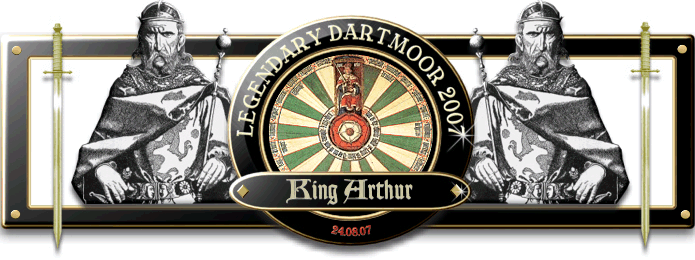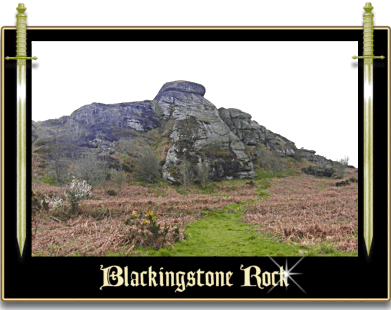
The most famous person to emerge from the Dark Ages was the legendary figure of King Arthur, Arturus, Artorius or have who you will. His history and background are to this day fiercely debated with the Scots, Welsh and English all claiming he was a son of their soil. For centuries tales of his exploits have been told around camp fires and hearths up and down the country, it seems that there was not a shire in the land where he did not visit at one time or another. Most of the tales are about his famous battles with invading hoards, dragons, and evil denizens of the underworld, including the Devil himself. As counties go Devonshire is no exception although he does not seem to have stayed too long on Dartmoor, judging by the Arthurian legends he must have made a whistle-stop tour. However he did stay long enough to do battle with the Devil and put the king of the underworld firmly in his place. Near to Moretonhampstead are two hills Hel tor and Blackingstone Rock. Originally they were just plain old hill tops as bare as a badgers arse with not a rock in site.. Then one day King Arthur engaged the devil in a hurling match. Presumably the loser would be banished from the land. So Arthur stood on Hel tor and the Devil stood on Blackingstone. The whistle blew and they began hurling mighty quoits at each other, before long they were landing everywhere, down in the valley and on both hillsides. Eventually as you would expect King Arthur won the match and the Devil in a fit of temper turned the last two remaining quoits into rock. Hence today Hel tor and Blackingstone are capped with two small tors or rather petrified quoits. This must have been a regular pastime of the Arthur and The Devil because there are confirmed reports of such duels up and down the country with similar evidence of their quoits.

On the top of Water Hill is King’s Oven which was a point of the perambulation of 1240, at this time it was called Furnum Regis or ‘King’s Oven’. The consensus of opinion seems to be that the ‘oven’ was in fact a place where tin was smelted and that it belonged to some king, now there are some moorfolk that would have you believe that the ‘king’ was no other than Arthur. Probably the same folks would have you believe that the spirit of King Arthur lives on in the form of a chough and that to kill such a bird would be to invite a terrible disaster. There are also murmurings that along with the oven was a chair which belonged to the king and was known as Arthur’s Chair, presumably this took the form of a rock or boulder? Not far from King’s oven are some old tin workings known as Chaw Gully, the name, “Chaw” being a dialect word for the chough hence chough valley or the valley where choughs lived. As King Arthur takes on the form of the chough it is not surprising that it was believed that he once lived in this valley.
In 1953/4 King Arthur was seen at Haytor where he had shed his feathers and once again took on a human form albeit in the guise of Mel Ferrer. The reason for this was that the famous film ‘Knights of the Round Table’ was shot on location at the tor. Along with Stanley Baker, Robert Taylor and Ava Gardiner the cast acted out the famous exploits of the Dark Ages king. Camelot castle was reconstructed near the tor which took advantage of the extensive views afforded on the down. Although at the time the critics described the film as, “disappointingly flat”, it did recieve two Oscar and one Cannes Film Festival nominations.
 Legendary Dartmoor The many aspects past and present of Dartmoor
Legendary Dartmoor The many aspects past and present of Dartmoor
